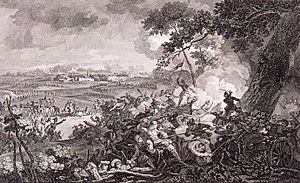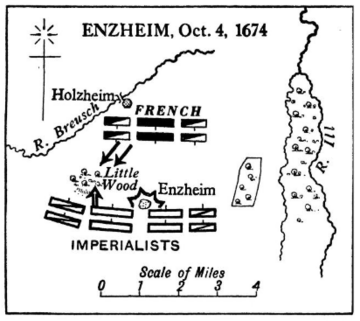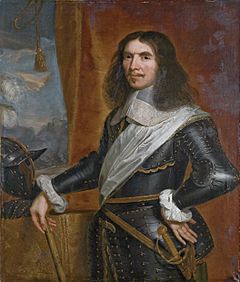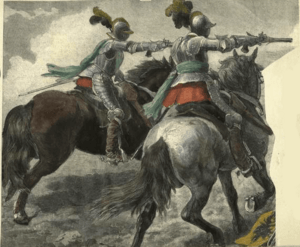Battle of Entzheim facts for kids
Quick facts for kids Battle of Entzheim |
|||||||
|---|---|---|---|---|---|---|---|
| Part of Franco-Dutch War | |||||||
 Battle of Enzheim (Martinet ill.; E. Ruhierre graveur.) |
|||||||
|
|||||||
| Belligerents | |||||||
| Commanders and leaders | |||||||
| Strength | |||||||
| 22,000 men 30 guns |
35,000–38,000 men 50 guns |
||||||
| Casualties and losses | |||||||
| 2,500–3,500 killed or wounded | 3,000 dead 4,000 killed or wounded 8–10 guns |
||||||
The Battle of Entzheim was a big fight that happened on October 4, 1674. It was part of the Franco-Dutch War, which lasted from 1672 to 1678. The battle took place near a town called Entzheim in Alsace, France.
The French army was led by a famous general named Turenne. They fought against an army from the Holy Roman Empire, commanded by Alexander von Bournonville. Even though Turenne's army was smaller, he was very good at moving quickly. This kept his enemies guessing.
Bournonville's army had more soldiers and a strong defensive spot. But after many French attacks, he decided to pull back. Turenne's army lost more soldiers compared to its size. Still, he stopped Bournonville from invading Eastern France. The battle is usually seen as a draw, but it gave the French a big boost in confidence. This set the stage for Turenne's amazing winter campaign later on.
Template:TOC limit=3
Why the Battle Happened
For a long time, France and the Dutch Republic both wanted control of the Spanish Netherlands. This area was important for their safety and trade. In 1667, French troops took over parts of it. But in 1668, King Louis XIV of France had to give it back to Spain.
Louis XIV then decided to defeat the Dutch first. This way, he hoped to force them to give up land in the Spanish Netherlands. The Franco-Dutch War began in May 1672. French troops quickly took over much of the Dutch Republic. But by July, the Dutch fought back and held their ground.
Other countries worried about France getting too powerful. So, Brandenburg-Prussia, Emperor Leopold, and Charles II of Spain joined the Dutch. In 1673, a French army in the Rhineland faced Imperial forces. The Imperial general, Raimondo Montecuccoli, was very clever. He outsmarted Turenne and helped the Dutch capture Bonn.
With enemies on many sides, Louis XIV gave up some of his earlier gains. He wanted to protect France's borders. In January 1674, Denmark also joined the fight against France. Then, in February, England left the war.
The allies decided to kick France out of the Netherlands. An Imperial army would also open a new front in Alsace. King Louis XIV put Turenne in charge of the army in Alsace. His job was to stop the Imperial forces from entering Eastern France. He also had to prevent them from joining up with the Dutch.
Turenne knew he wouldn't get more soldiers. The longer he waited, the worse his situation would become. So, he decided to attack first. French armies at this time had some big advantages. They had one clear leader, skilled generals, and excellent supplies. They could move much faster than their enemies. This allowed them to fight for longer periods.
Turenne used this to his advantage. He attacked his enemies one by one. At Sinsheim in June, he caused heavy losses to a group of Imperial soldiers. In August, the French army in Flanders won a battle against the Dutch and Imperial forces. This helped ease the pressure on France's northern border.
In early September, about 40,000 Imperial soldiers entered Alsace. They crossed the Rhine River at Strasbourg. Their leaders were Bournonville and Caprara. Bournonville then moved to Entzheim. He was waiting for another 20,000 soldiers to arrive. These new troops were led by Frederick William, Elector of Brandenburg. With all these soldiers, Bournonville planned to easily defeat the French.
Turenne decided to attack before these extra soldiers could arrive. On the night of October 2-3, he left Molsheim. He crossed the Bruche River. He arrived at Entzheim early on October 4. His fast movement surprised Bournonville. It also cut him off from Strasbourg.
The Battle Unfolds
Bournonville had many more soldiers than Turenne. He had 35,000 men, with half of them being cavalry (soldiers on horseback). He also had 50 cannons. Even with more soldiers, Bournonville decided to fight defensively. He knew Turenne had to attack right away. If Turenne waited, he would be trapped between Bournonville's army and Frederick William's troops. Also, rain and mist made it hard to see, which helped the defenders.
Most of Bournonville's foot soldiers (infantry) were in the middle. They were based around Entzheim. Cavalry led by Charles of Lorraine supported them. On the right side, his troops were hidden by fields and vineyards. These led into a forest called Foret de Bruche. His left side was protected by a ditch. This ditch ran from the village to a small forest called the 'Little Wood'.
The cavalry was split evenly on both sides. On the right were the best Imperial Cuirassiers. These were heavily armored cavalry. On the left were German units. The 'Little Wood' was a very important spot for Bournonville. Turenne's army had to take it to attack Entzheim. So, Bournonville placed eight cannons and six groups of foot soldiers in the wood. He kept another eight groups ready behind them.
Turenne arranged his army in two lines. His foot soldiers were in the middle. His cavalry was on the sides. The right side was led by the Marquis de Vaubrun. The left side was led by Turenne's nephew, Guy Aldonce de Durfort de Lorges. Turenne placed special grenadier companies between his cavalry groups. This was a tactic copied from Gustavus Adolphus. His cannons were placed in front of his foot soldiers. There were four groups of eight cannons each.
The second line and reserve included four English regiments. These were known as the British Brigade. They were led by George Hamilton. One of these regiments was led by John Churchill. He later became the famous Duke of Marlborough. Even though England had left the war, these soldiers stayed with the French.
Around 10:00 am, the French attacked the Little Wood. They used eight groups of foot soldiers and dragoons (soldiers who could ride horses or fight on foot). Their leader was Louis Francois de Boufflers. The first attack was pushed back. They tried again, with four more groups of soldiers. Churchill's group was one of them.
The Imperial commander, Holstein-Ploen, sent more soldiers to help. Heavy rain and mud made it hard for the French cannons to move forward. After two hours of intense fighting, the French pulled back. They had lost many soldiers.
Two English units lost many officers and men. Churchill later said Turenne's plan was not good. Instead of another direct attack, Vaubrun's cavalry tried to go around the Little Wood. They wanted to attack the defenders from behind. But Holstein-Ploen stopped them. At the same time, the heavily armored cuirassiers attacked the French left side. The battle was very close. But the wet ground slowed down the Austrian charge. They lost their formation. This allowed de Lorges to gather his troops. He pushed the Austrians back to where they started.
Meanwhile, a third attack by the rest of Hamilton's British brigade finally captured the Little Wood. This put the Imperial left side in danger. Vaubrun tried to attack the Imperial troops around Entzheim, but it didn't work. Turenne stopped the direct attacks. Instead, he used his cannons to bombard them.
It was getting dark, and both sides were very tired. Bournonville had lost between 3,000 and 4,000 men. He ordered his army to retreat. The French had been marching or fighting for 40 hours straight. They had lost about the same number of soldiers. Turenne knew his army couldn't attack again. So, he pulled back, leaving a small group of cavalry. This way, he could say he won the battle.
What Happened Next
The Imperial army went to rest for the winter near Colmar. Turenne did not chase them. His own army had lost about 3,500 men. Many of these losses were from the British brigade, which was later broken up. Turenne took his army north to Dettwiller. There, his tired soldiers could rest and get new supplies.
The Battle of Entzheim was a tactical draw, meaning neither side clearly won on the battlefield. But it was a strategic victory for France. Even though Bournonville had more soldiers, Turenne stopped him from entering French land.
The British Brigade lost so many men at Entzheim. Also, the English Parliament made it harder to get new soldiers. So, the brigade's numbers dropped a lot. Churchill and other officers went back to England. In May 1675, Parliament ordered any remaining soldiers in France to return home. However, Hamilton's regiment, mostly Irish Catholics, stayed with the French army throughout the war. One of its officers was Patrick Sarsfield. He later became an important commander in other wars.
The campaign that began in June 1674 and ended with Turenne's death in July 1675 is called his most brilliant campaign. Even though he was greatly outnumbered, he used cleverness and bravery. He fought the Imperial army to a standstill at Entzheim. With his enemy now quiet, he could plan his famous winter movement. This led to a big victory at the Battle of Turckheim.
The village of Entzheim still exists today. However, most of the old battlefield is now covered by the Strasbourg International Airport.




